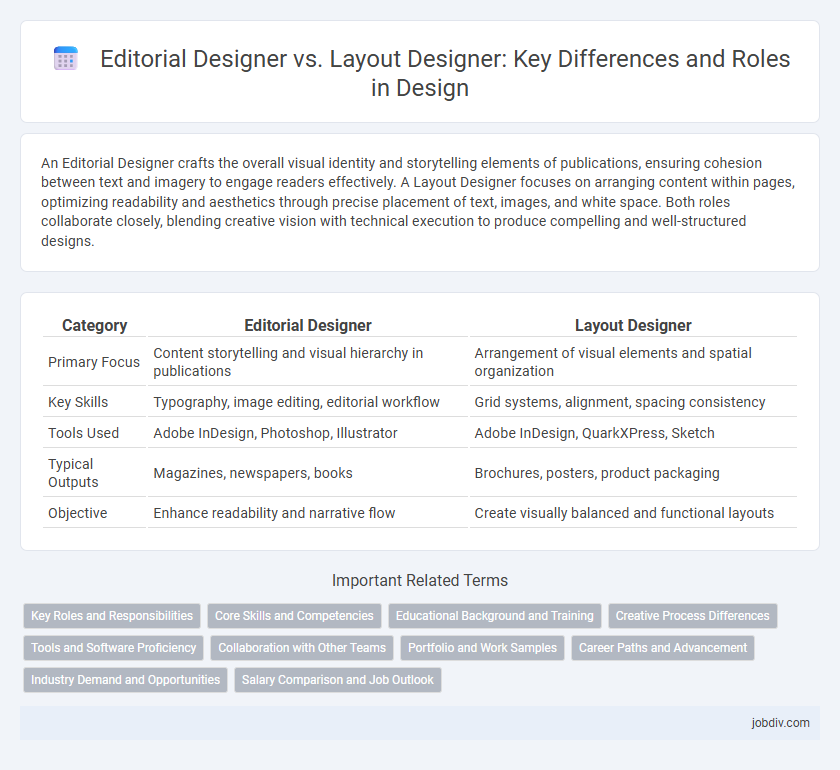An Editorial Designer crafts the overall visual identity and storytelling elements of publications, ensuring cohesion between text and imagery to engage readers effectively. A Layout Designer focuses on arranging content within pages, optimizing readability and aesthetics through precise placement of text, images, and white space. Both roles collaborate closely, blending creative vision with technical execution to produce compelling and well-structured designs.
Table of Comparison
| Category | Editorial Designer | Layout Designer |
|---|---|---|
| Primary Focus | Content storytelling and visual hierarchy in publications | Arrangement of visual elements and spatial organization |
| Key Skills | Typography, image editing, editorial workflow | Grid systems, alignment, spacing consistency |
| Tools Used | Adobe InDesign, Photoshop, Illustrator | Adobe InDesign, QuarkXPress, Sketch |
| Typical Outputs | Magazines, newspapers, books | Brochures, posters, product packaging |
| Objective | Enhance readability and narrative flow | Create visually balanced and functional layouts |
Key Roles and Responsibilities
Editorial Designers focus on creating visually appealing content that enhances readability and supports the narrative flow of articles and publications. Layout Designers specialize in organizing text and images within a page or spread, ensuring balanced composition, alignment, and spatial hierarchy. Both roles demand proficiency in design software such as Adobe InDesign and a keen understanding of typography, grid systems, and print or digital production workflows.
Core Skills and Competencies
Editorial Designers excel in typography, visual storytelling, and content hierarchy to create engaging narratives across print and digital media. Layout Designers specialize in grid systems, balance, and spatial organization to ensure clarity and visual harmony in multi-page documents. Both roles demand proficiency in design software, attention to detail, and a solid understanding of brand guidelines and user experience.
Educational Background and Training
Editorial Designers typically possess formal education in graphic design or visual communication, often holding a bachelor's degree with coursework in typography, color theory, and publication design. Layout Designers usually gain specialized training through certificate programs or hands-on experience that emphasizes grid systems, software proficiency such as Adobe InDesign, and spatial arrangement of text and images. Both roles benefit from internships and portfolio development to demonstrate mastery of design principles and industry standards.
Creative Process Differences
Editorial designers concentrate on conceptualizing and developing the overall visual narrative, integrating typography, imagery, and text flow to enhance storytelling within publications. Layout designers focus on the precise arrangement and spatial organization of design elements, ensuring consistency, readability, and functional alignment across pages. The editorial designer drives the creative vision, while the layout designer translates this vision into coherent, practical page structures.
Tools and Software Proficiency
Editorial designers excel in software like Adobe InDesign and QuarkXPress, focusing on typographic hierarchy and content flow to create visually compelling magazine and book layouts. Layout designers specialize in tools such as Sketch, Figma, and Adobe XD, emphasizing grid systems and spatial organization for digital interfaces and print materials. Mastery of these distinct software suites shapes the efficiency and quality of design outputs tailored to specific editorial or layout needs.
Collaboration with Other Teams
Editorial designers collaborate closely with writers, editors, and photographers to craft visually engaging content that aligns with the publication's voice and storytelling goals. Layout designers work alongside graphic designers, printers, and production teams to ensure that the final design maintains consistency, readability, and print quality. Both roles require seamless communication and coordination to deliver cohesive, high-impact editorial projects.
Portfolio and Work Samples
An Editorial Designer's portfolio showcases expertise in integrating typographic hierarchy, visual storytelling, and content flow to enhance reader engagement in magazines, books, and digital publications. Layout Designers emphasize precision in grid systems, spatial organization, and alignment, demonstrating skills in arranging elements for clarity and aesthetic balance across print and digital formats. Strong work samples highlight an Editorial Designer's ability to combine narrative with visuals, while Layout Designers focus on structural coherence and usability.
Career Paths and Advancement
Editorial designers specialize in creating visually compelling content for magazines, books, and digital publications, often combining text and images to enhance storytelling and reader engagement. Layout designers focus primarily on arranging text and graphics within a given space, emphasizing structure, readability, and visual balance across various media formats. Career advancement for editorial designers typically involves roles like creative director or art director, while layout designers may progress into senior design positions or specialize in UX/UI design to expand their skill set and industry impact.
Industry Demand and Opportunities
Editorial designers specialize in creating visually compelling content for magazines, newspapers, and digital publications, with strong demand in media and publishing industries transitioning to digital platforms. Layout designers focus on the arrangement of text and images across various formats, maintaining high demand in advertising agencies and corporate branding, where clear communication and user experience are paramount. Opportunities for editorial designers often involve storytelling and content strategy roles, while layout designers find broader applications in web design, product packaging, and marketing collateral.
Salary Comparison and Job Outlook
An Editorial Designer typically earns a median salary ranging from $50,000 to $75,000 annually, reflecting expertise in content styling and publication aesthetics, while Layout Designers often command salaries between $45,000 and $70,000, emphasizing spatial arrangement and user readability. The job outlook for Editorial Designers is projected to grow by 6% over the next decade, driven by digital media expansion and multimedia publishing needs. Layout Designers face a slightly slower growth rate of 4%, with demand influenced by print and digital format developments.
Editorial Designer vs Layout Designer Infographic

 jobdiv.com
jobdiv.com